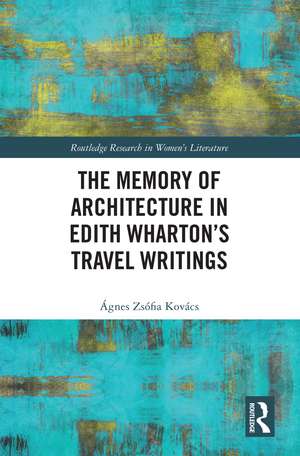The Memory of Architecture in Edith Wharton’s Travel Writings: Routledge Research in Women's Literature
Autor Ágnes Zsófia Kovácsen Limba Engleză Hardback – 13 sep 2024
Preț: 973.84 lei
Preț vechi: 1187.61 lei
-18% Nou
Puncte Express: 1461
Preț estimativ în valută:
186.37€ • 193.85$ • 153.86£
186.37€ • 193.85$ • 153.86£
Carte tipărită la comandă
Livrare economică 14-28 aprilie
Preluare comenzi: 021 569.72.76
Specificații
ISBN-13: 9781032580265
ISBN-10: 1032580267
Pagini: 226
Ilustrații: 20
Dimensiuni: 152 x 229 mm
Greutate: 0.48 kg
Ediția:1
Editura: Taylor & Francis
Colecția Routledge
Seria Routledge Research in Women's Literature
Locul publicării:Oxford, United Kingdom
ISBN-10: 1032580267
Pagini: 226
Ilustrații: 20
Dimensiuni: 152 x 229 mm
Greutate: 0.48 kg
Ediția:1
Editura: Taylor & Francis
Colecția Routledge
Seria Routledge Research in Women's Literature
Locul publicării:Oxford, United Kingdom
Public țintă
PostgraduateCuprins
Acknowledgements
List of illustrations
Introduction
1. Wharton’s view of cultural continuity in Italian Villas (1904) and Their Gardens (1905)
Influences and editorial interventions
Villas and tradition
Wharton’s definition of “villa”
Renaissance tour
Baroque tour
Villas and art history
Nature and culture in garden architecture
Manners in garden architecture
Writing the history of art and architecture
2. Uncatalogued treasures: Travels in art history via Edith Wharton’s Italian Backgrounds (1905)
Sources and book
The seen and the unseen: John Ruskin’s Italy
Publication and reception
Wharton’s visions of Italy: “deconventionalized” scenes
Foreground and background
Scenes of observation
Fact and fancy in Wharton’s painterly vision
Wharton’s backgrounds
3. Historical Continuity in A Motor-Flight Through France (1908)
Influences, editing and illustrations, contemporary reviews
Historical continuity in space
Continuity in landscape and architecture
Renovations contra ruins
Cathedrals as symbols: a sentimental model of appreciating continuity
The stakes of historical understanding in Wharton
4. The war of images: Edith Wharton’s architectural reports of war in Fighting France (1915)
Antecedents, articles to book, early reviews
Visions of war and cultural destruction in Fighting France
The role of art history and propaganda in Wharton’s language of war
5. A Motor-Flight Through North Africa: The Miracle of Morocco
Composition, publication, contemporary reception
Wharton’s Moroccan Orient: history, dreams, women
Facts and dreams of the Moroccan past
Moroccan harems
Wharton’s architectural vision in her colonial war reports
6. Edith Wharton’s quest for historical continuity in the Aegean
Antecedents and publication history: Homer, Goethe, and Ruskin in the typescript
Observing architecture in The Cruise of the Vanadis
Architectural vision in the Osprey Notes
Absence and presence of the past in Athens and Crete
7. Edith Wharton’s travel fragments about Spain
Where the fragments come from: Wharton’s readings in art history
St. James’s Way: Wharton’s Spanish cathedral trail in the “Spain Diary,” “Back to Compostela” and “A Motor-Flight Through Spain”
Architectural vision in “A Motor-Flight Through Spain”
Conclusion
Index
List of illustrations
Introduction
1. Wharton’s view of cultural continuity in Italian Villas (1904) and Their Gardens (1905)
Influences and editorial interventions
Villas and tradition
Wharton’s definition of “villa”
Renaissance tour
Baroque tour
Villas and art history
Nature and culture in garden architecture
Manners in garden architecture
Writing the history of art and architecture
2. Uncatalogued treasures: Travels in art history via Edith Wharton’s Italian Backgrounds (1905)
Sources and book
The seen and the unseen: John Ruskin’s Italy
Publication and reception
Wharton’s visions of Italy: “deconventionalized” scenes
Foreground and background
Scenes of observation
Fact and fancy in Wharton’s painterly vision
Wharton’s backgrounds
3. Historical Continuity in A Motor-Flight Through France (1908)
Influences, editing and illustrations, contemporary reviews
Historical continuity in space
Continuity in landscape and architecture
Renovations contra ruins
Cathedrals as symbols: a sentimental model of appreciating continuity
The stakes of historical understanding in Wharton
4. The war of images: Edith Wharton’s architectural reports of war in Fighting France (1915)
Antecedents, articles to book, early reviews
Visions of war and cultural destruction in Fighting France
The role of art history and propaganda in Wharton’s language of war
5. A Motor-Flight Through North Africa: The Miracle of Morocco
Composition, publication, contemporary reception
Wharton’s Moroccan Orient: history, dreams, women
Facts and dreams of the Moroccan past
Moroccan harems
Wharton’s architectural vision in her colonial war reports
6. Edith Wharton’s quest for historical continuity in the Aegean
Antecedents and publication history: Homer, Goethe, and Ruskin in the typescript
Observing architecture in The Cruise of the Vanadis
Architectural vision in the Osprey Notes
Absence and presence of the past in Athens and Crete
7. Edith Wharton’s travel fragments about Spain
Where the fragments come from: Wharton’s readings in art history
St. James’s Way: Wharton’s Spanish cathedral trail in the “Spain Diary,” “Back to Compostela” and “A Motor-Flight Through Spain”
Architectural vision in “A Motor-Flight Through Spain”
Conclusion
Index
Notă biografică
Ágnes Zsófia Kovács is Associate Professor at the Department of American Studies, University of Szeged, Hungary. Her research interests include late-nineteenth-century proto-modern fiction, conversions of literary modernisms, popular fiction genres, and contemporary multicultural American fiction. Her current research into travel writing involves remapping travel texts by Edith Wharton. She has published two books, The Function of the Imagination in the Writings of Henry James: The Production of a Civilized Experience (2006) and Literature in Context (2010), co-edited Space, Gender and the Gaze (2017), and edited Edith Wharton’s Osprey Notes (2021). She sits on the editorial boards of Americana E-Journal and TNTeF E-Journal, Szeged; and Acta Philologica, Cluj (RO).
Descriere
It focuses on Wharton’s symbolic representations of architecture in her travel writings. It shows how allusions to travel writing and art history influenced her representations of spaces. How the shock of the Great War changed Wharton’s travel destinations but not her symbolic view of architecture as a mediator of the past.








